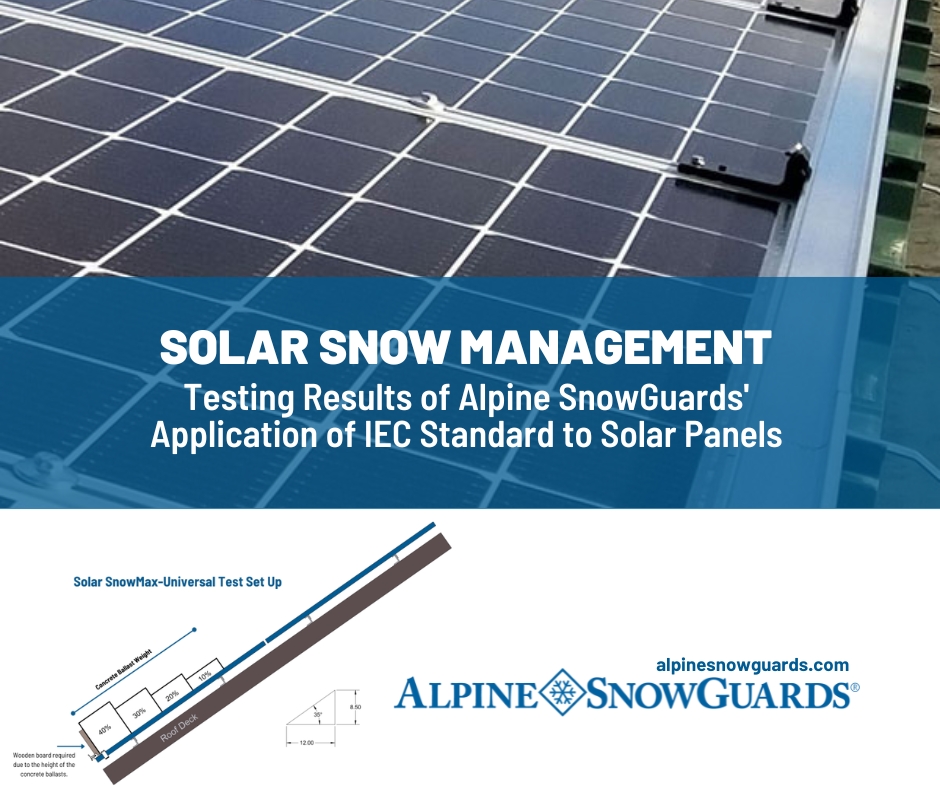With over 25 years’ experience designing and manufacturing snow guards, Alpine SnowGuards’ products provide optimal performance that uphold the structural and water-tight integrity of roofs regardless of roofing material.
Our patented snow retention for solar panels applies time-tested solutions to a modern problem: avalanching snow off roof-mounted solar arrays. Alpine approached solar snow retention with data-driven engineering.
Alpine launched its solar snow management products in 2012 in response to several years of fielding questions about avalanching snow off roof-mounted solar panels. In that time, we honed our engineering calculations for layout recommendations and product design.
Here are important considerations Alpine factored into its solar snow guard products:
- Solar industry-standard safety factor
- Allowable loads for solar panels
- Allowable loads for snow retention brackets attached to solar panels
- Roof pitch, rafter length, roof materials friction, ground snow loads (GSL)
Alpine’s Three-Part Solar Snow Guard System
Alpine’s solar snow guard system comprises three main components:
1) SSG-313: a roof-mounted, pipe-style snow guard system
2) Solar SnowMax-Universal: an array-mounted fence-style system installed at the lowest edge of the solar array.
3) Solar Snow Dog: a 6-inch wide individual pad-style snow guard implemented between solar panels in the horizontal joint upslope in the array.
Depending on size, pitch and location of array, Alpine solar snow retention components can be installed alone or, for best performance, in combination with one another.
All of Alpine’s products undergo rigorous performance testing.
Immediate takeaways from solar snow guard testing include:
- Solar arrays installed in snowy climates will shed snow in a glacial or avalanche-style event; even on slopes as low as 5°.
- Solar snow management is a mitigation system that will allow the snow to naturally melt or to be removed as needed without a roof avalanche event.
- Alpine testing performed supported the load values established in our layout guides.
- Combining Solar Snow Dogs with a roof-mounted snow guard system with an ample landing zone is the ideal solution, allowing the bottom row of solar panels to clear with limited kinetic loading of the roof-mounted snow guard system.
- If a roof-mounted system with an appropriate landing zone is not an option, then the Solar Snow Dog combined with the SSM-Universal is the best option.
- The Solar SnowMax-Universal and Solar Snow Dog systems are well tested, with variations in continuous service since 2012 with no reported failures.
Success is Realized via Proper Installation
“I have not seen our solar snow guards fail on any system, anywhere or cause damage to it when they were installed properly,” said Kris Michaud, Alpine’s technical support manager.
IEC Standard for Solar Panels: Vertical & Vector Loads
Solar panels must pass an IEC safety standard through rigorous testing.
- IEC 62938:2020 provides a method for determining how well a framed PV module performs mechanically under the influence of inclined non-uniform (inhomogeneous) snow loads.
- IEC 61215:2021 provides a method for evaluating solar panel performance against static and dynamic loads applied to the front and back faces of the panel (wind and snow loads). Testing is conducted by loading solar panels on a horizontal racking system with ballast.
- To pass the IEC 61215:2021 standard, panels must withstand approximately 5,400 pascals for snowy environments. This equates to roughly 112 pounds per square foot.
Inhomogeneous Mechanical Loading (IEC 62938:2020) Test Set Up Example

- Framed solar panels are tested for Mechanical Load (ML) as a test of module strength
- Inhomogeneous (non-uniform) Mechanical Loading Test is designed to test reliability against snow on a pitched roof surface
Alpine Applied IEC Standard to Solar Snow Retention
To assure our snow retention will not damage solar panels, we applied IEC standard testing for solar panels to solar panels with snow retention installed.
Alpine’s Solar Snow Guard Testing: Solar SnowMax Universal & Solar Snow Dog
Alpine has performed mechanical testing of Solar SnowMax-Universal and Solar Snow Dog snow guards at our facility in Vermont on test panels with concrete pavers as the ballast weight. Our tests follow the test loading protocol established in IEC 61215:2021.
Solar SnowMax Universal System
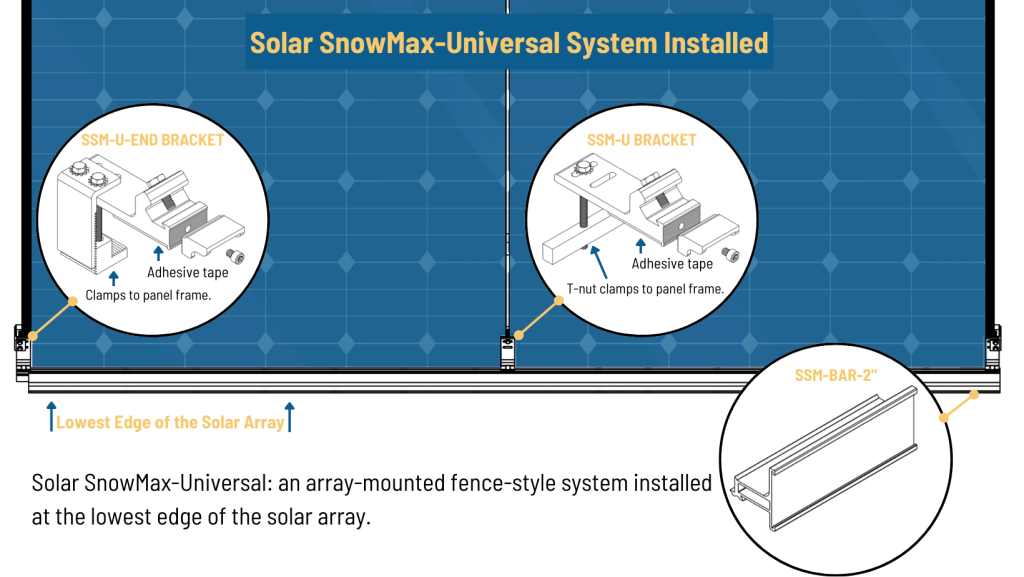
Solar SnowMax-Universal system components include clamp-on and adhered end brackets (SSM-U-End), clamp-on and adhered mid brackets (SSM-U), and a 2″ tall bar that mechanically fastens onto both bracket designs. Adhesive tape used on the SSM-U system is designed to provide additional shear resistance. The clamping mechanism provides positive pressure on the adhesive tape and resists overturning. Combining the clamping mechanism and tape strengthens the attachment; where one mechanism is weak, the other is strong.
Alpine SnowGuards’ Test Procedure Summary – Solar SnowMax-Universal
- Four solar panels were attached to solar racking in portrait orientation, which was attached to the roof structure via L-feet.
- Solar SnowMax Universal (SSM-U) system was installed with one end bracket on each side of the array and one mid-bracket in the joint between the two panels.
- Each solar panel was loaded with 1,200 pounds of ballast by loading the lower 2/3rds of the panel evenly in layers. As each ballast load zone was completed, the loading continued in the lower zones until complete.
- The 2,400-pound total test load was chosen to emulate the maximum total load anticipated from instrumented testing to cause tape displacement.
- The ultimate failure of the system was considered to be a maximum tape displacement of 1/4” or greater.
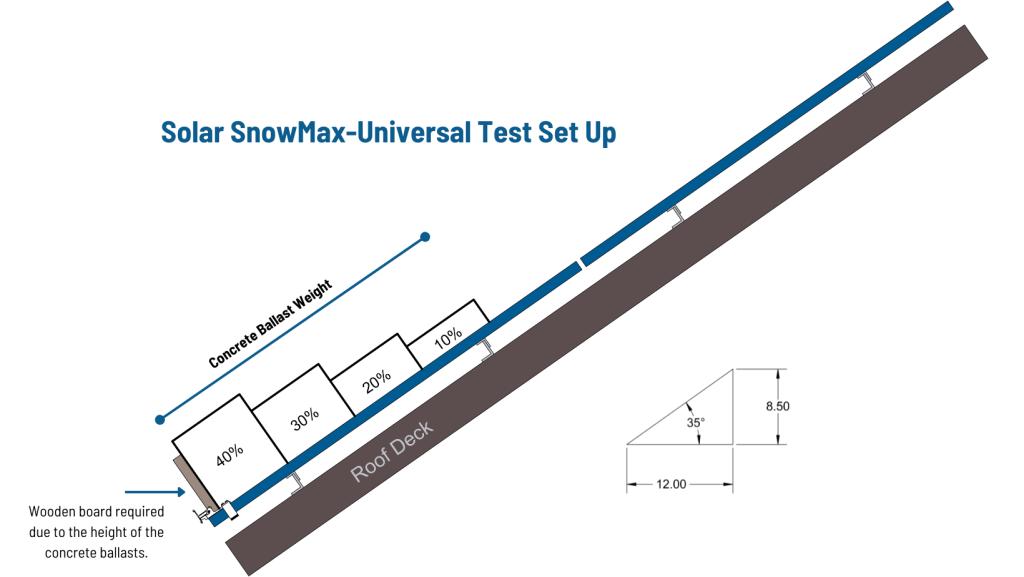
Solar SnowMax-Universal Results
- Alpine’s Solar SnowMax-Universal system on a single panel held a 1,200 lb load in place for a period of 24 hours. The adhesive tape was the failure point, displacing more than 1/4”.
- During this test, the panels also began to deform under the weight, but glass and frame returned to their original shape after the weight was removed:
- In the Solar SnowMax-Universal system, the mid-clamp (joining two panels) supported 1,200 pounds. On a 35.5° pitch, the vector load against the clamp would be approximately 58% or 696 pounds. This translates into an allowable weight load of 400 pounds per bracket with a safety factor of 1.5.
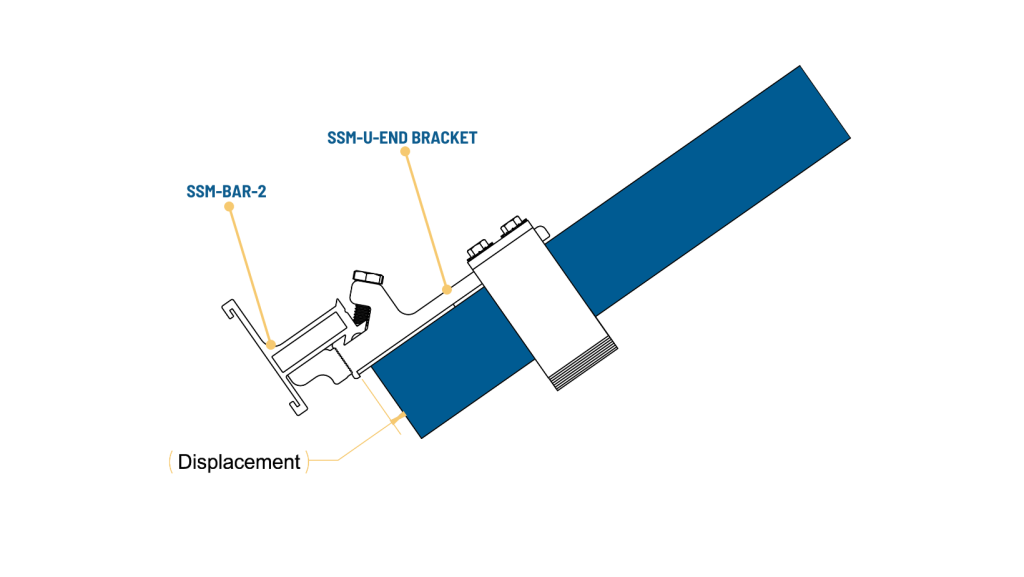
Solar Snow Dog Installed

Solar Snow Dog is a 6” pad-style snow guard installed in the upslope, horizontal joints of the solar array. Snow is viscous and as snow weights increase and the mass presses against the Solar Snow Dog, the snow begins to push around and over the Solar Snow Dog. This is what we refer to as a managed release. In order to further manage the snow, we recommend 2 Solar Snow Dogs for portrait solar panel orientation and 3 Solar Snow Dogs for landscape orientation.
Alpine SnowGuards’ Test Procedure Summary – Solar Snow Dog
- Solar Snow Dog-BLK was tested following the same test array setup as the Solar SnowMax Universal, except that it was limited to one panel with a single Solar Snow Dog in the middle of the panel.
- It was loaded until a significant deflection of the solar panel was observed due to rotational force imparted on the panels via the Solar Snow Dog.
Solar Snow Dog Supports Allowable Load
- Solar Snow Dog rotated against the panel frame at a load of 1,200 pounds, supporting the desired allowable load of 300 pounds per clamp (45° slope).
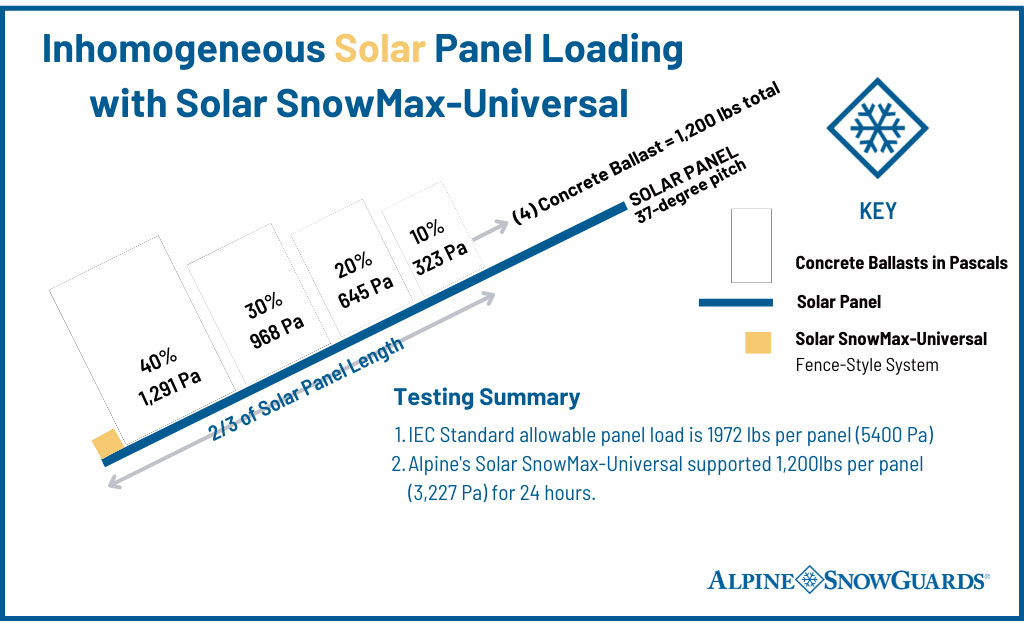
Alpine’s Solar Snow Management Test Conclusions
- All mechanical load testing results for Alpine’s Solar SnowMax-Universal and Solar SnowDog were within the panel manufacturer’s specification/warranty for vertical load limitations
- Testing showed that solar snow guards, when used within Alpine SnowGuards’ suggested constraints, do not impose damage to solar panels
